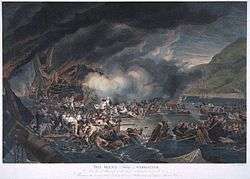James Jefferys
James Jefferys (19 May 1751 – 31 January 1784) was a British engraver and painter. His work was reassessed in the 1970s following the discovery of a lost set of drawings in Maidstone.
James Jefferys | |
|---|---|
 self-portrait | |
| Born | 19 May 1751 |
| Died | 31 January 1784 Soho, London |
| Nationality | British |
Life
Jefferys was born in Maidstone in 1751 to William and Parnell Jefferys; his father was a coach painter and artist.[1] He spent time working under William Woollett who was also born in Maidstone. Jefferys enrolled at the Royal Academy and his talent was marked with a gold medal for a drawing titled Seleucus and Stratonice in 1773. That year he started exhibiting at the Society of Artists and the following year he gained a prize from the Society.[2] The Dilettante Society underwrote the expense of three years in Rome after a recommendation by Sir Joshua Reynolds. Jefferys stretched this to four years and returned with a number of well regarded classical drawings of violent subjects, but no paintings are known.[3] Jefferys was known to have had a wild time[4] and some reported his behaviour as odd.[2] Jefferys' drawings were in the style of James Barry and John Hamilton Mortimer (Jefferys may have worked with Mortimer whilst he was at the Royal Academy).[3]

When he returned to England he established his own studio at Meard's Court in Soho. His most important work was The Scene before Gibraltar on the morning of 14 Sept. 1782 which he exhibited at the Royal Academy in 1783. The subject of the painting took place during the Great Siege of Gibraltar when the Spanish built purpose built ships that were floating batteries designed to be unsinkable. Jefferys' past master, William Woolett, undertook an engraving of the painting but John Emes had to complete the task after Woolett died.[3]
Jefferys died in Soho, London, unmarried, from a cold at the end of January 1784.[4]
Legacy
Jefferys' Gibraltar painting was exhibited at the European Museum in 1804. Many drawings by Jefferys were erroneously attributed to James Barry and John Hamilton Mortimer until they were reassigned in the 1970s. This came about following the discovery of a collection of his drawings in Maidstone.[2] Jefferys has work in the National Portrait Gallery[5] and the Victoria and Albert Museum, and his painting of the battle at Gibraltar is at Maidstone Museum & Art Gallery.[6] His work is regarded as important but derivative.[3]
References
| Wikimedia Commons has media related to James Jefferys. |
- 4 paintings by or after Willam Jefferys at the Art UK site
- Pressly, William L (2007). "James Jefferys' Appropriation of Shakespeare's Mantle". The Artist as Original Genius. Newark: University of Delaware Press. p. 112. ISBN 978-0874139853.
- Martin Myrone, "Jefferys, James (1751–1784)", Oxford Dictionary of National Biography, Oxford University Press, 2004; online edn, accessed 15 September 2013.
- Timothy Clifford and Susan Legouix, "James Jefferys Historical Draughtsman (1751-84)", The Burlington Magazine, Vol. 118, No. 876 (March 1976), pp. 148–155+157, retrieved September 2013.
- James Jefferys, Self-portrait c. 1774–75, National Portrait Gallery, retrieved September 2013
- 2 paintings by or after James Jefferys at the Art UK site